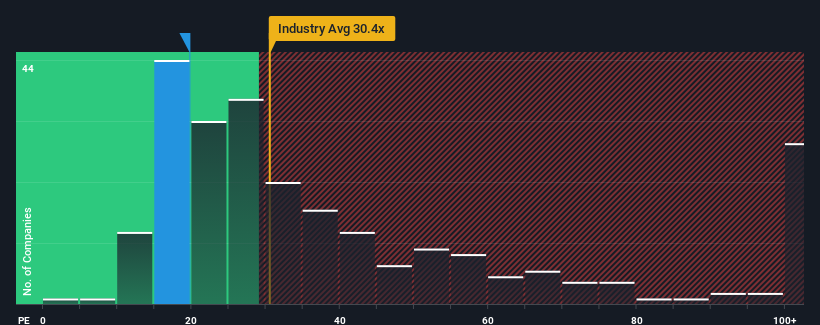- China
- /
- Electrical
- /
- SHSE:601126
There's No Escaping Beijing Sifang Automation Co.,Ltd's (SHSE:601126) Muted Earnings

Beijing Sifang Automation Co.,Ltd's (SHSE:601126) price-to-earnings (or "P/E") ratio of 19.7x might make it look like a buy right now compared to the market in China, where around half of the companies have P/E ratios above 31x and even P/E's above 58x are quite common. Although, it's not wise to just take the P/E at face value as there may be an explanation why it's limited.
Beijing Sifang AutomationLtd certainly has been doing a good job lately as it's been growing earnings more than most other companies. One possibility is that the P/E is low because investors think this strong earnings performance might be less impressive moving forward. If you like the company, you'd be hoping this isn't the case so that you could potentially pick up some stock while it's out of favour.
Check out our latest analysis for Beijing Sifang AutomationLtd

What Are Growth Metrics Telling Us About The Low P/E?
Beijing Sifang AutomationLtd's P/E ratio would be typical for a company that's only expected to deliver limited growth, and importantly, perform worse than the market.
Taking a look back first, we see that the company managed to grow earnings per share by a handy 12% last year. Pleasingly, EPS has also lifted 75% in aggregate from three years ago, partly thanks to the last 12 months of growth. Accordingly, shareholders would have probably welcomed those medium-term rates of earnings growth.
Shifting to the future, estimates from the seven analysts covering the company suggest earnings should grow by 17% each year over the next three years. Meanwhile, the rest of the market is forecast to expand by 20% per annum, which is noticeably more attractive.
With this information, we can see why Beijing Sifang AutomationLtd is trading at a P/E lower than the market. It seems most investors are expecting to see limited future growth and are only willing to pay a reduced amount for the stock.
The Key Takeaway
Using the price-to-earnings ratio alone to determine if you should sell your stock isn't sensible, however it can be a practical guide to the company's future prospects.
We've established that Beijing Sifang AutomationLtd maintains its low P/E on the weakness of its forecast growth being lower than the wider market, as expected. Right now shareholders are accepting the low P/E as they concede future earnings probably won't provide any pleasant surprises. Unless these conditions improve, they will continue to form a barrier for the share price around these levels.
And what about other risks? Every company has them, and we've spotted 2 warning signs for Beijing Sifang AutomationLtd you should know about.
Of course, you might also be able to find a better stock than Beijing Sifang AutomationLtd. So you may wish to see this free collection of other companies that have reasonable P/E ratios and have grown earnings strongly.
Valuation is complex, but we're here to simplify it.
Discover if Beijing Sifang AutomationLtd might be undervalued or overvalued with our detailed analysis, featuring fair value estimates, potential risks, dividends, insider trades, and its financial condition.
Access Free AnalysisHave feedback on this article? Concerned about the content? Get in touch with us directly. Alternatively, email editorial-team (at) simplywallst.com.
This article by Simply Wall St is general in nature. We provide commentary based on historical data and analyst forecasts only using an unbiased methodology and our articles are not intended to be financial advice. It does not constitute a recommendation to buy or sell any stock, and does not take account of your objectives, or your financial situation. We aim to bring you long-term focused analysis driven by fundamental data. Note that our analysis may not factor in the latest price-sensitive company announcements or qualitative material. Simply Wall St has no position in any stocks mentioned.
About SHSE:601126
Beijing Sifang AutomationLtd
Supplies power transmission, transformation protection, automation systems, power generation, enterprise power, and power distribution and consumption systems in China and internationally.
Very undervalued with flawless balance sheet and pays a dividend.

